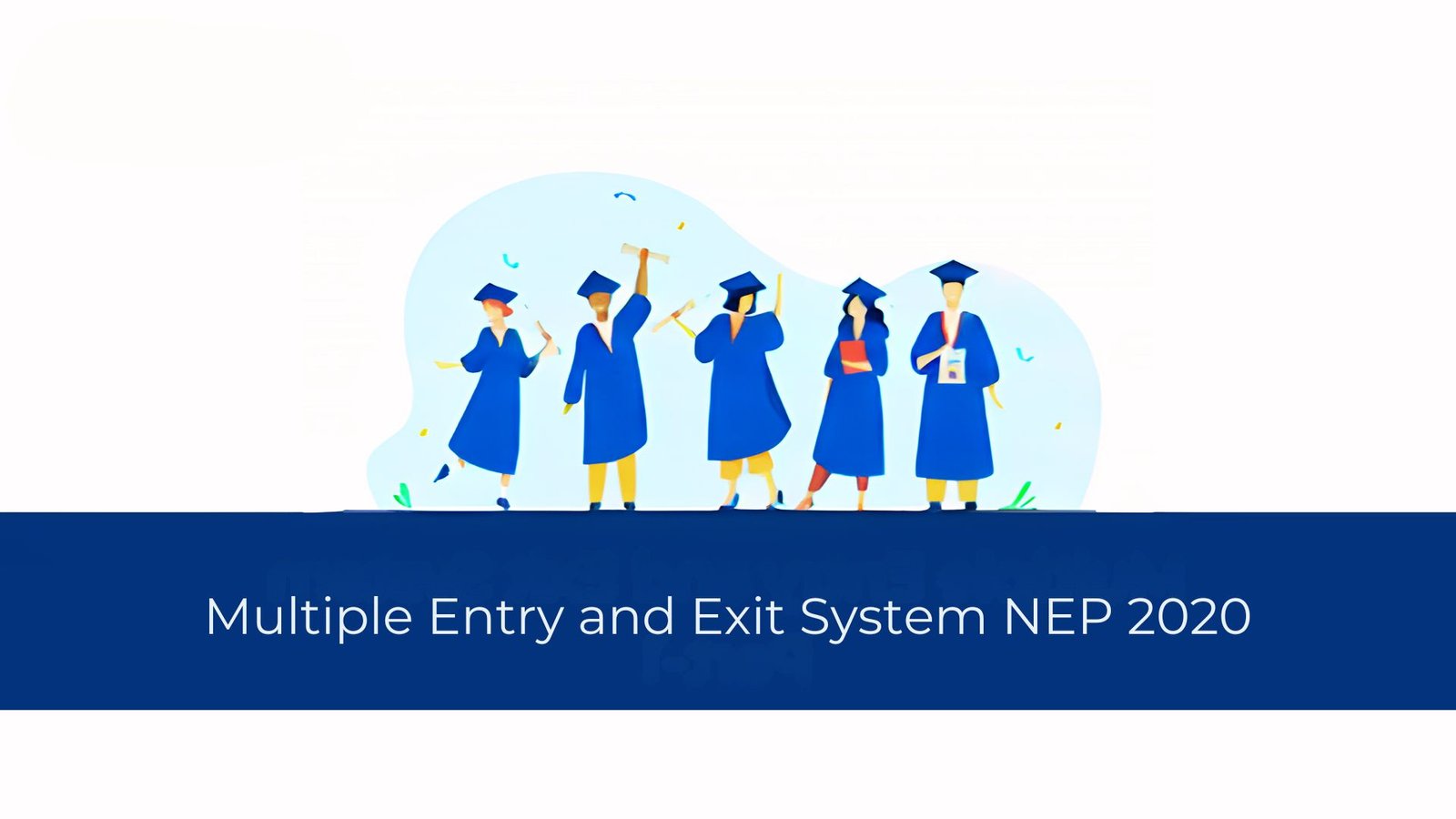Multiple Exit Multiple Entry Paradigm Shift of National Education Policy 2020
Contents
Multiple Exit Multiple Entry
Introduction
The National Education Policy 2020 (NEP 2020) has brought about a revolutionary change in the Indian education system, aiming to transform it into a dynamic and flexible framework that meets the needs of the 21st century. One of the significant reforms introduced is the concept of Multiple Exit Multiple Entry (MEME), a flexible approach to education that allows learners to enter and exit educational programs seamlessly, catering to diverse learning needs and career aspirations.
Understanding Multiple Exit Multiple Entry:
Multiple Exit Multiple Entry is a departure from the traditional linear trajectory progression in education. Under this system, learners have the flexibility to enter and exit academic programs at various stages, earning certificates and diplomas along the way, and ultimately culminating in a degree. This approach acknowledges that learning is a lifelong process and that individuals may have different educational and career pathways.
Read Our another article: What is NEP 2020 policy
Key Features of MEME:
Flexibility for Learners:
MEME provides autonomy to learners with the flexibility to choose their educational journey based on their interests, aptitudes, and evolving career goals. Students can join or leave a program at different stages without facing rigid constraints. This adaptability ensures that education remains a dynamic and personalized experience.
Modular and Interdisciplinary Courses:
MEME promotes the development of modular courses, allowing learners to focus on specific skills or subjects of interest. Interdisciplinary courses facilitate a holistic understanding of various disciplines, fostering a well-rounded education preparing students for the complexities of the modern world.
Recognition of Prior Learning:
The policy recognizes and values prior learning experiences, whether acquired through formal education, vocational training, or work experience. This ensures that individuals are not required to repeat what they have already learned. This recognition eliminates redundancy, acknowledging the wealth of knowledge individuals bring to the educational landscape.
Credit Accumulation and Transfer:
MEME incorporates a credit accumulation and transfer system, enabling students to earn credits for completed courses. These credits can be transferred across institutions, promoting mobility and a seamless transition between educational institutions.
Vocational Education Integration:
The policy emphasizes the integration of vocational education with mainstream academic programs, providing learners with practical skills and making them job-ready. This integration helps bridge the gap between education and employment that students are not only academically proficient but also equipped with the practical skills demanded by the job market.
Inclusive Education:
MEME fosters inclusivity by accommodating diverse learning styles and paces. Learners with varied abilities can navigate their educational paths at their own pace, ensuring that education is accessible to all.
Global Compatibility:
The credit transfer system enhances the global compatibility of Indian education. Students can seamlessly transition between domestic and international institutions, promoting a global perspective and cross-cultural experiences.
Technology Integration:
MEME leverages technology to facilitate online learning, making education accessible beyond the confines of traditional classrooms. This integration enhances the reach of education, especially in remote areas.
Read Out our Article on Academic & Bureaucracy Drift NEP 2020
Benefits of Multiple Entry Multiple Exit
Customized Learning Paths:
MEME allows learners to tailor their educational paths, ensuring that education meets individual needs and interests fostering a sense of ownership and engagement. This customization enhances engagement and motivation among students.
Reduced Dropout Rates:
By providing multiple exit points with recognized certifications, MEME reduces the stigma associated with dropping out. Learners who exit early still possess tangible achievements, potentially re-entering the system with newfound motivation.
Enhanced Employability:
The focus on vocational education and skill development equips students with practical skills, enhancing their employability and preparing them for the demands of the workforce by addressing the skill gap between education and industry requirements.
Diverse Career Opportunities:
MEME opens up diverse career opportunities by recognizing a spectrum of skills and experiences. This flexibility encourages learners to explore different fields before making definitive career choices.
Understanding Multiple Entry and Multiple Exit?
In other words, the MEES is an opportunity for financially challenged students to complete their studies on their own.
Probably the economic factor is only one among many that causes dropouts in higher education.
Other reasons like social, familial, religious, etc., are also prevalent in India. For example, girls who get married early or are pregnant while pursuing a degree and those who are experiencing physical hardship due to accidents or diseases will see the MEES as a blessing.
A more in-depth analysis of the concept shows practical complications and the attempt to turn education from a social responsibility to a personal responsibility.
The Multiple Entry and Multiple Exit (MEME) option in the New Education Policy 2020 is a provision that allows students to enter and exit academic programs at different stages while earning credits for the completed courses.
It provides flexibility to learners by enabling them to choose their academic pathway and pursue a combination of disciplines.
The MEME system aims to curtail the dropout rate, improve the Gross Enrollment Ratio (GER), and offer creative combinations of study disciplines1. Undergraduate degrees are designed to be either 3 or 4 years long, with multiple entry and exit options within this period.
Students can receive certifications such as a certificate after completing 1 year in a discipline, including vocational and professional areas; a diploma after 2 years of study; or a Bachelor’s degree after a 3-year program.
Concerns associated with MEME
If institutions allow MEME, it would be very difficult for the institutions to predict how many students would exit and how many would join midway. Since institutions would not know the in- and out-traffic, it will certainly disturb the pupil-teacher ratio.
The concern that uneven geographical distribution of higher educational institutions would create hurdles in managing MEME in several areas, mostly the countryside.
The institutions have not thought very clearly about this problem and how they will resolve it when it is at their doorstep.
Though enrolment in higher education in India is only about 26%, the dropout rate is low compared to the school level. According to figures released by the Minister of Education in Parliament in February 2020, the dropout rate in IITs is just 1% in 2020. But with the implementation of MEES, this is likely to rise sharply. The concept of multiple exits legitimises student dropouts.
The MEES does not have the provision to ensure that the students who exited will join back.
The vast majority is likely to fall into the trap of deciding to go as far as possible with the work they are currently doing and the pay they are getting out of it. Fatalism is a major driving force for a majority of Indians.
Institutes may impose restrictions on the number of students likely to resume their studies each year. So, MEES would not ensure entry according to the will of the students, but on the conditions of the institutions.
At the same time, multiple-entry admission in government colleges and universities can be given only by following the reservation policy. Private institutions, on the other hand, would deem this a good opportunity to charge exorbitant fees to those students who seek entry back to resume their studies.
MEES may appear to be a student-friendly policy, but it implies that education is a private responsibility. While no child in a financially secure home will drop out of college due to the want of money, MEES, if implemented, will result in a distorted educational experience for financially disadvantaged students.
However, with the general consensus that students can study on their own, it will be a good justification to withdraw all such scholarships.
Higher education institutions (HEIs) may now effectively store students’ academic credits thanks to the implementation of the Academic Bank of Credits. It enables students to pause their undergraduate or graduate studies and return at any time. Students have embraced the new system, but many questions remain for colleges. The most crucial query is: How will several entrances and exits function?
The undergraduate degree should be of either a 3 or 4-year duration, with multiple entries and exit options within this period, with appropriate certifications. For example,
- A certificate after completing one year in a discipline or field including vocational and professional areas;
- A diploma after two years of study;
- A Bachelor’s degree after a three-year programme;
However, the four-year interdisciplinary Bachelor’s degree is the best choice since it gives students the chance to focus on their major and minor courses according to their preferences while also providing them with the opportunity to experience the complete spectrum of holistic and multidisciplinary education. If the student successfully completes a demanding research project in the major area(s) of study as designated by the HEI, the four-year curriculum may also result in a degree in research.
The Academic Bank of Credits or ABC gives students multiple entry and exit options for life-long learning. It allows users to select from a variety of courses to create their own curriculum and choose their disciplines. As a result, making education more convenient for students and allowing them to select the most suitable pace of learning.
- To understand the working of ABC and the multiple entry/exit system, here’s a look at the objectives of the new system –
- Removing strict barriers from the educational system to provide students more opportunities. Students’ acquired credits will be valid for seven years. Additionally, after a break, students will be able to use their credits to rejoin a programme.
- Higher education dropout rates can be decreased and the GER can be improved overall with the equity and flexibility provided by the new system.
- Novel pairings of topics to provide for several points of entry and departure. Students can now choose from a variety of academic fields to customise their graduation courses.
- Offering students curriculum flexibility and new course alternatives outside of discipline-specific specialisations. Students might use this to learn tangential information unrelated to their topic of study.
- To provide many master’s programme designs. In addition to the field of study they select, it will enable students to include original combinations of disciplines into their master’s programme.
- Accumulation and transfer of credits will make lifelong learning possible. With the evaluation and validation of non-formal and informal education provided, students can earn credit and transfer it towards the awarding of a degree.
- When a student returns to their course of study, the system enables them to encash in the credits they have earned.
Conclusion:
The introduction of Multiple Exit Multiple Entry under the National Education Policy 2020 heralds a new era in Indian education, promoting flexibility, inclusivity, and a learner-centric approach. This innovative system empowers individuals to chart their own educational journeys, fostering a culture of lifelong learning and adaptability. As the education landscape continues to evolve, MEME stands as a beacon of progressive change, aligning education with the dynamic needs of the 21st century.
MEME aligns education with the dynamic needs of the society. This innovative system not only empowers individuals to navigate their educational journeys but also positions Indian education on a global stage, ready to meet the challenges and opportunities of the future


One thought on “Multiple Exit Multiple Entry Paradigm Shift of National Education Policy 2020”
Comments are closed.